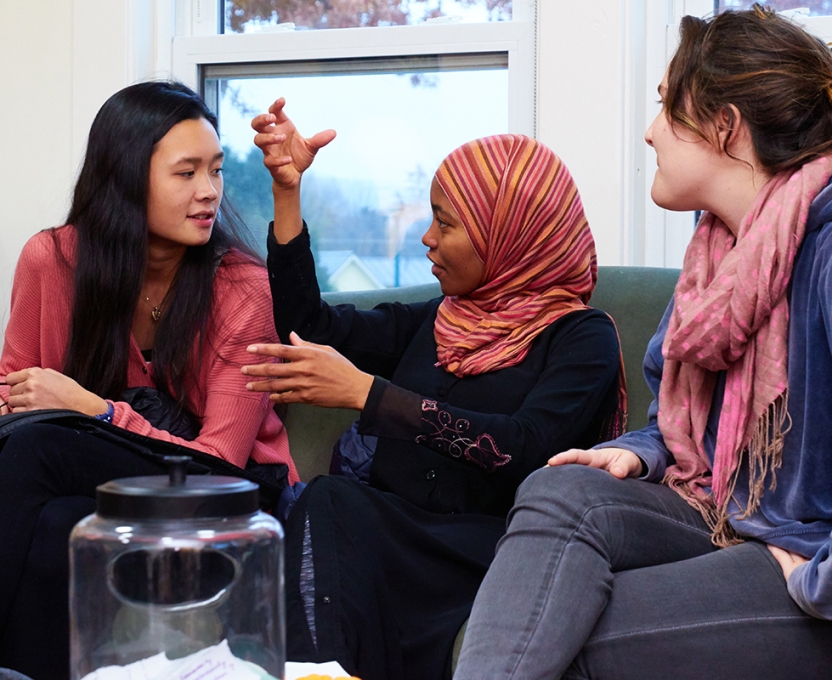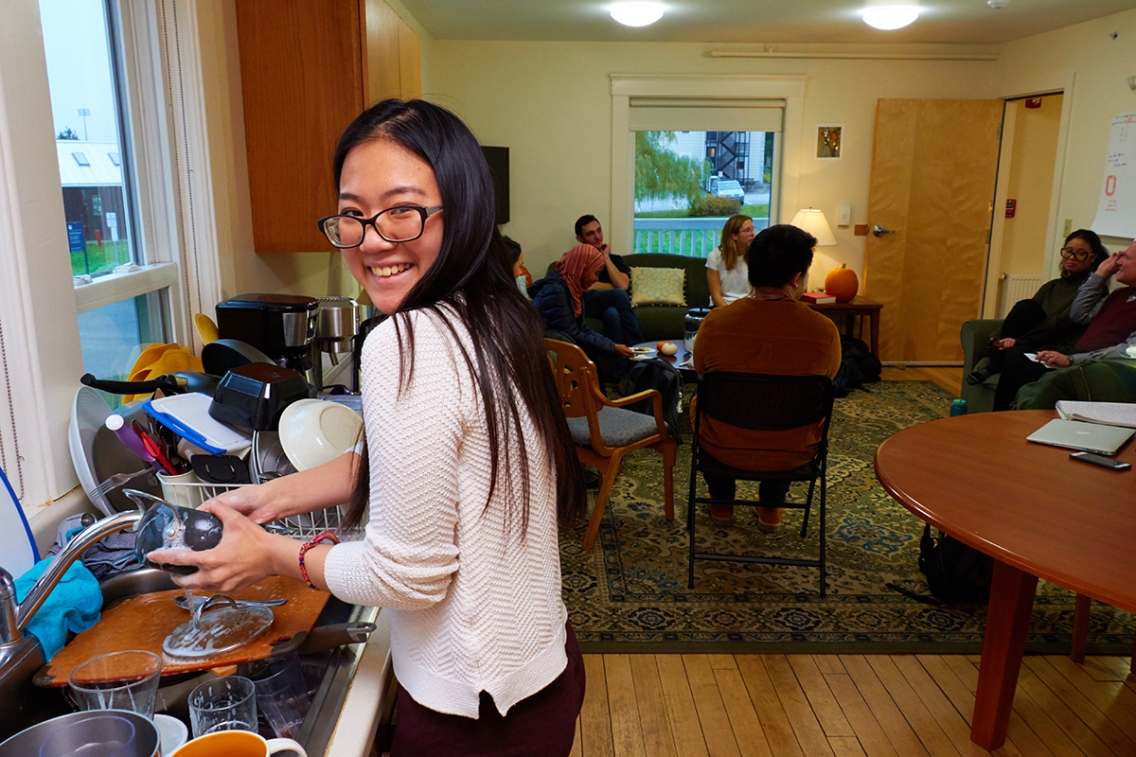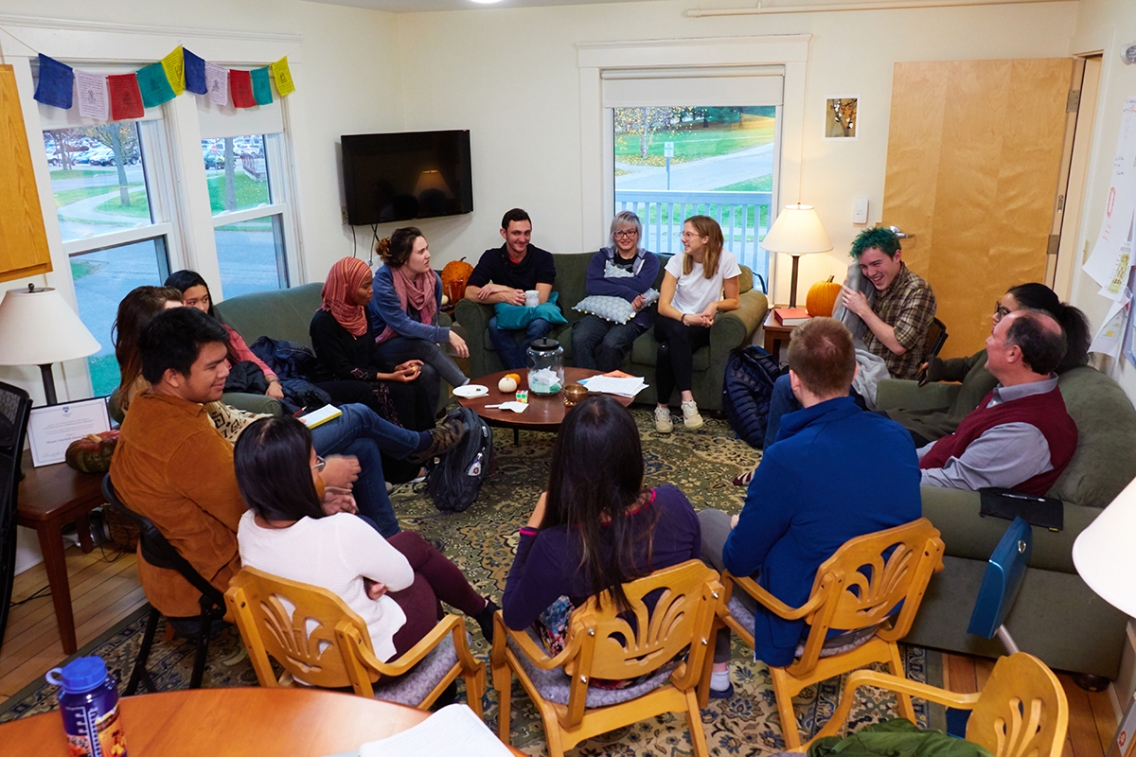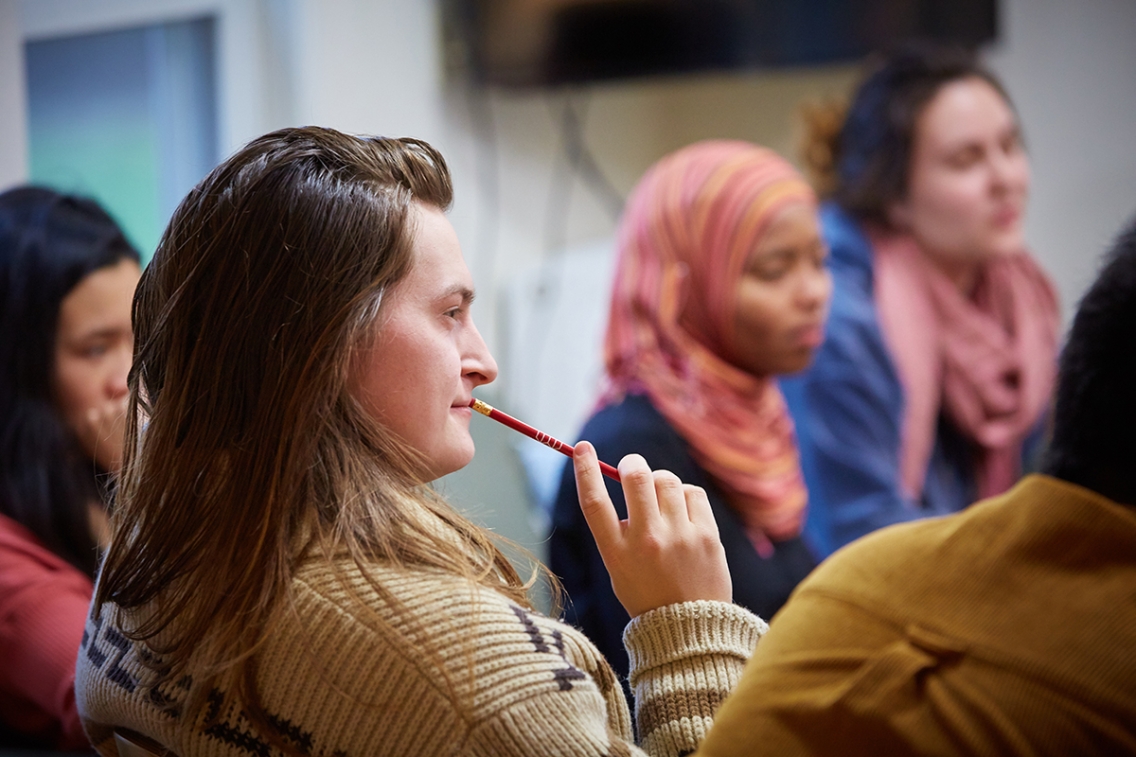Mosaic House Brings Students of Diverse Faiths to Live and Listen under One Roof

MIDDLEBURY, Vt. – Chattiness turns to stillness as Mark Orten, dean of spiritual and religious life, sounds a singing bowl. There’s a casualness, almost, in how the 11 students in today’s circle make the shift. But there’s something else beneath the surface, a powerful pull, a sudden and unexpected letting go of the everyday self, such that even as an observer I find myself startled—like a snake that’s unexpectedly shed its skin or like when someone asks you how you are and you say “OK” and then they stop, look you in the eyes, and say, “No. Really.”
Welcome to Mosaic Interfaith House, now in its second year. With its establishment, Middlebury joins a small vanguard of undergraduate institutions (about a dozen nationwide) who’ve created interfaith residential communities.
This fall the 14 students in residence come from across the United States and around the globe, bringing diverse cultural and ethnic backgrounds and a range of faith and religious expressions, including Christian, Muslim, Buddhist, Shinto, Daoist, atheist, nature oriented, and those who are still seeking.
“Having a place we can talk about these things without harsh feelings really opens people up; I can’t imagine people just talking about God or abortion or death and demons in a dining hall,” said senior Shan Zeng, a religion and art history joint major. “It’s different.”
“It gives me the space to be able to talk about any issue,” said senior Travis Sanderson, a global and international studies major.

Tessa Nguyen is one of 14 students living at the Mosaic Interfaith House.
“We’re here as a group of people who are trying to intentionally live together,” added Kate Monroe, a senior and Chinese major.
“We share our foods and languages and religions and different academic backgrounds,” said Fatmata Bah, a molecular biology and biochemistry major with a focus on premed. “There’s a lot of richness to that.”
Zeng grew up in Sichuan province, in a China that still considered religion “the opiate of the masses.” She is a spiritual seeker, drawn to Buddhism, who loved the diversity of spiritual life she experienced when she went to high school in Singapore. Sanderson grew up Baptist, in Germany and in Las Vegas. He, too, is drawn to Buddhism. Monroe grew up Brethren in the D.C.-area church her mom still pastors and belongs to Gather, a progressive Christian group at Middlebury. She describes herself as someone who’s always “got a hymn stuck in my head.” Bah, a Muslim, grew up in a devout Muslim household in Sierra Leone, part of a multifaith society in which Christians and Muslims mingle easily side by side. “We have people who are like ‘Yeah I’m a ChrisMus because my mom is a Christian and my dad is a Muslim,’” explained Bay. “So it’s like we have that mix and match.”
Middlebury’s experiment in interfaith living is an active search for “a model for how we might live in the world,” said Orten.
In part, this search is about global citizenship. “We need to increase the vocabulary and the literacy about religious and nonreligious worldviews and traditions,” said Orten. “To be citizens, global citizens, of the 21st century, students will need to have the ability to articulate their own particularities in good company with those of others, as a way of living harmoniously rather than merely tolerating one another.”
In part, it’s about recognizing the spiritual life “not as incidental, or as only a preferential ascription, but as elemental to the identities of certain students because of their cultural backgrounds and the ways in which they formulate their worldviews.” Spiritual life also includes atheist and agnostic outlooks, emphasized Orten, who defines religion as “our deepest convictions and our highest values and how we articulate them.”
At its heart, Mosaic Interfaith House is about being present and listening—deeply enough to be changed.

Students living in the Mosaic House represent a wide range of faiths and religious expressions, including Christian, Muslim, Buddhist, Shinto, Daoist, atheist, nature oriented, and those who are still seeking.
“It is the first-person, lived experience of one another that we are after,” said Orten. “The point of dialogue in community is the sustained knowing of one another’s convictions and commitments, and how those interact with one another in daily, lived experience. How do we understand the other better when we have a living relationship with them and know their full context for deeper understanding of where they are coming from?”
Bah said she was drawn to Interfaith House because “I was looking for a space where I felt like religion was used in a positive way and where I felt like I belonged and had something to contribute.” Bah is part of the Muslim Student Association and often treks from science classes in Bicentennial Hall to the Forest Hall prayer room. Yet being a religious person at Middlebury, said Bah, “sometimes it can feel very isolated.” Monroe, too, had been struggling to find a wider space on campus “where there’s room for those conversations about what we believe and why we believe, conversations that drive to the essence of spiritual experience.”
Both feel they’ve found a home in Mosaic Interfaith House, a sense of home that sometimes comes with surprising connections.
“The other day, I was talking to Kate,” said Bah, “and she was whistling ‘One More Step Along the World I Go’ and I was like ‘I know that hymn!’ and it was so amazing. It made me feel at home.” Bah said that hymn is frequently sung at Christian weddings in Sierra Leone.
Anchoring Mosaic Interfaith House is the weekly gathering held on Friday afternoons. Orten facilitates, along with coadvisor and Muslim chaplain Saifa Hussain. It’s a time to check in, share reflections, and address logistics.
“It’s really helpful to have everyone face to face,” said Monroe. “It plants a little seed each week, a reminder that we’re there to be there together.”
For Sanderson, one of the most radical aspects of living together intentionally is the degree to which housemates engage.
“You can’t really have great conversations when you’re fitting it in between two meetings,” said Sanderson. “The Interfaith House offers that. People will listen, instead of looking at their watches for the next hour.”

Chris Diak listens to one of his housemates at the Mosaic Interfaith House during one of their weekly meetings.
Conversations largely arise out of the rhythms of everyday living: cooking in the kitchen, hanging out in the living room. Day to day, students cook for themselves. But students also come together for impromptu and planned celebrations: a late-night homemade pie party, Saturday morning brunches, evening tea and cookies.
Monroe described how small moments can lead to deeper conversations.
“Two weeks ago I was feeling really sick, so I just lay down on the couch and was taking a nap and Shan came in. She turned the lights off, made me some tea, got me some cough drops, and we had this conversation about caring for each other.”
She and Zeng delved into how hard it can be to accept help from others without feeling like you’re “burdening” them and about the difference between an ethos of “self-care” and one of caring for each other.
“We talked about how that combats loneliness, how it can be really lonely amidst the business of life—not just students but people in the world.”
As with any family or community, living together can have challenges. While housemates easily decided that everyone would keep the kitchen halal, it took several weeks to find a workable approach to keeping the kitchen clean. Adjusting noise levels can also be a concern.
“It requires patience and a willingness to be forgiving because we’re sharing an emotional and physical space,” said Monroe.
Added Sanders, “There’s a value to a same-faith community, and there’s a value to a diverse, within-difference community, which is what the Interfaith House is.”
“This kind of interfaith living is so essential, when globalization is happening on unprecedented levels, and people travel and mingle and mix so much more than they ever did,” said Zeng. “What’s the new way of coexistence?”
“One thing my mom has always pushed for us to understand and appreciate,” said Bah, “is that at the end of the day humanity matters the most. In the Quran it talks about ‘We created you in different nations so that you could live with each other.’ The Interfaith House reaffirms that it’s not just an idea, it’s actually something that’s achievable.”
By Gaen Murphree; Photos by Todd Balfour

